Snowflake QUALIFY clause is an essential yet lesser-known filtering method in Snowflake. It is not unique to Snowflake—other big data warehouses like Oracle and BigQuery also use it. Snowflake introduced this feature around ~2021. But what problem does the QUALIFY clause solve? It addresses a common SQL issue—filtering the results of window functions, which are typically evaluated after the WHERE clause. Instead of using subqueries or CTEs to filter window function results, the QUALIFY clause allows for direct filtering on window functions within the same query, applied after the window calculations have been performed.
In this article, we will cover everything you need to know about the Snowflake QUALIFY clause in detail—its purpose, execution, how it enables advanced analytic capabilities and the efficiencies it brings to SQL queries in Snowflake. We’ll explore everything from its technical syntax to practical application—and so much more!!
What Are Window Functions and Their Role in Snowflake?
Before diving into Snowflake QUALIFY, let's first understand what a window function is. A window function operates on a group (or “window”) of related rows in a query result set. It is applied to each row in the window and returns a value based on the other rows in that window.
Common types of window functions:
- Aggregates: Apply aggregate functions like SUM(), COUNT(), AVG() over a window.
- Ranking: Rank rows in a window such as ROW_NUMBER(), RANK(), DENSE_RANK(). Requires ORDER BY clause.
- Analytics: Compute values based on a window frame like cumulative sums or moving averages. Require ORDER BY clause.
- Offset: Access rows around the current row like LAG() and LEAD(). Require ORDER BY clause.
Check out the documentation to learn more about the list of Functions that Support Windows
Common use cases and key properties of window functions are:
- Calculating aggregates like sum, average, etc over a sliding window of rows rather than the entire result set.
- Ranking rows within a window according to some criteria. For example, ranking employees by salary within the department.
- Retrieving the first, last, or nth value in an ordered window. Useful for pattern or gap detection.
- Windows can be logically defined using PARTITION BY and ORDER BY.
Window functions lend Snowflake much of its analytical muscle. Nearly any type of data analytics you can imagine—from sales data insights to network analysis—leverages window functions.
But there's a catch when using window functions—you can't filter the result set directly based on them in a WHERE clause! This is because window functions are calculated after WHERE clause filters. So how do you filter rows based on window function output?
The traditional method was subqueries or Common Table Expressions (CTEs). But this could result in complex, hard-to-maintain SQL. Enter Snowflake QUALIFY clause...

Want to take Chaos Genius for a spin?
It takes less than 5 minutes.

How Did Snowflake QUALIFY in Snowflake Evolve and What Need Does It Address?
Snowflake first introduced the QUALIFY clause in around ~2021 as part of its window function capabilities. It provides an elegant solution to filter result sets based on window functions without subqueries.
QUALIFY acts as an additional filter that comes after window functions are calculated. So you can reference window functions directly in the QUALIFY predicate to filter rows.
The execution order of a query places QUALIFY evaluation after the computation of window functions. Typically, the clauses in a SELECT statement are evaluated in the following sequence:
By slotting in right after window functions, QUALIFY enables direct filtering on their output.
Syntax and Usage of Snowflake QUALIFY
Here is an in-depth look at the syntax and usage details of the Snowflake QUALIFY clause:
Basic Syntax
The basic syntax of Snowflake QUALIFY is:
QUALIFY <predicate>Where <predicate> is an expression that filters rows after window function calculation.
Some key notes:
- The predicate works similarly to a WHERE clause, but operates on the output of window functions rather than base data.
- The predicate expression can reference window functions and columns in the SELECT list using aliases.
- Aggregates and subqueries are allowed in the predicate.
Overall Syntax (Position in Query)
QUALIFY is used within a SELECT statement, generally following this structure:
SELECT columns
FROM table
[WHERE ...]
[GROUP BY ...]
[HAVING ...]
QUALIFY predicate
[ORDER BY ...]
[LIMIT ...]Required Window Function
At least one window function must be used in either:
- The SELECT column list
- Snowflake QUALIFY predicate expression
- This makes sure Snowflake QUALIFY is actually filtering on the window function output.
Referencing Window Functions
Any window function in the SELECT list can be referenced in the Snowflake QUALIFY predicate by its column alias.
For example:
SELECT
...,
ROW_NUMBER() OVER (ORDER BY date) AS row_num
FROM ...
QUALIFY row_num BETWEEN 5 AND 10Predicate Expression
The predicate expression can be any valid conditional expression, similar to WHERE or HAVING clauses. It commonly uses comparison operators like =, !=, >, >= etc.
Boolean operators like AND/OR are allowed to chain multiple conditions.
Example Syntax
Subqueries
Subqueries are valid in the Snowflake QUALIFY predicate. This allows things like filtering based on values calculated in a subquery.
For example:
QUALIFY col1 IN (SELECT MAX(col2) FROM table2)Aggregates
Aggregate functions can be used in the predicate per the same rules as the HAVING clause. This includes filtering based on a window aggregate calculation.
For example:
QUALIFY SUM(amount) OVER (PARTITION BY id) > 100Filter based on window function in SELECT:
SELECT ...,
ROW_NUMBER() OVER (PARTITION BY id) AS row_num
FROM data
QUALIFY row_num BETWEEN 1 AND 5TLDR; Snowflake QUALIFY enables elegant filtering based on window functions without subqueries. Its syntax fits cleanly within standard SELECT statements.
Practical Use Cases of Snowflake QUALIFY
Let's start with a simple example to illustrate the syntax and capability of Snowflake QUALIFY.
First, we'll create and populate a sample STUDENTS table:
CREATE TABLE STUDENTS (
STUDENT_ID NUMBER,
NAME VARCHAR,
GRADE NUMBER
);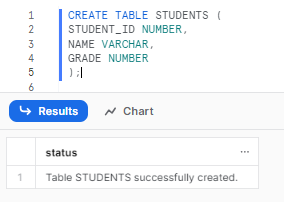
INSERT INTO STUDENTS VALUES
(1, 'Chaos', 90),
(2, 'Genius', 80),
(3, 'Johnnyy', 75),
(4, 'Mike', 85);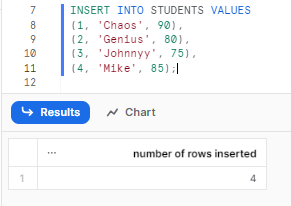
Now we can write a query to rank students by grade, and use QUALIFY to only return students with a rank of 2 or higher:
SELECT
NAME,
GRADE,
RANK() OVER (ORDER BY GRADE DESC) AS RANK
FROM STUDENTS
QUALIFY RANK >= 2;This would return:
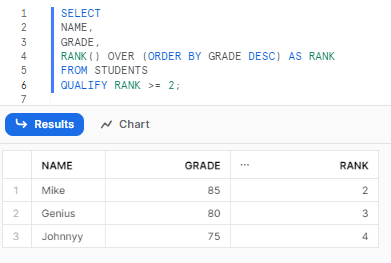
Snowflake QUALIFY clause filters the results to only rows where the RANK window function meets the condition of being 2 or greater.
Without Snowflake QUALIFY, we would have to use a subquery:
SELECT NAME, GRADE, RANK
FROM (
SELECT
NAME,
GRADE,
RANK() OVER (ORDER BY GRADE DESC) AS RANK
FROM STUDENTS
)
WHERE RANK >= 2;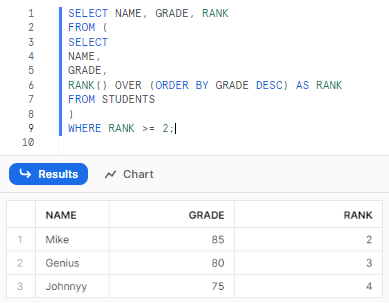
So as you can see, in simple cases, Snowflake QUALIFY just avoids the extra syntax of nesting the query.
Example 1—Getting Top N Per Group Using Snowflake QUALIFY
A common analytical query pattern is getting the top N rows per group based on some criteria. Snowflake QUALIFY makes solving this type of problem much cleaner.
Let's add a new COUNTRY column to our STUDENTS table:
ALTER TABLE STUDENTS ADD COLUMN COUNTRY VARCHAR;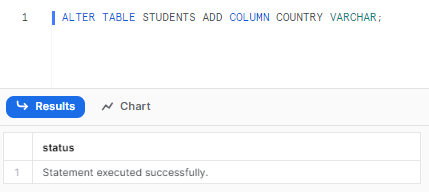
UPDATE STUDENTS SET COUNTRY = 'USA' WHERE STUDENT_ID IN (1, 2);
UPDATE STUDENTS SET COUNTRY = 'INDIA' WHERE STUDENT_ID IN (3, 4);Now we can make use Snowflake QUALIFY to get the top student by grade in each country:
SELECT
NAME,
GRADE,
COUNTRY
FROM STUDENTS
QUALIFY ROW_NUMBER() OVER (PARTITION BY COUNTRY ORDER BY GRADE DESC) = 1;This would return:
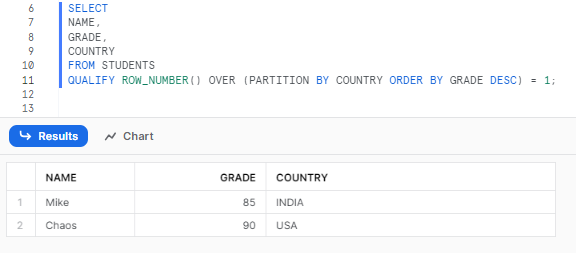
The window function ROW_NUMBER() creates a ranking over the GRADE for each COUNTRY group. QUALIFY filters this down to just the first row per group.
Without QUALIFY, we would need:
SELECT
NAME,
GRADE,
COUNTRY
FROM (
SELECT
NAME,
GRADE,
COUNTRY,
ROW_NUMBER() OVER (PARTITION BY COUNTRY ORDER BY GRADE DESC) AS ROW_NUM
FROM STUDENTS
)
WHERE ROW_NUM = 1;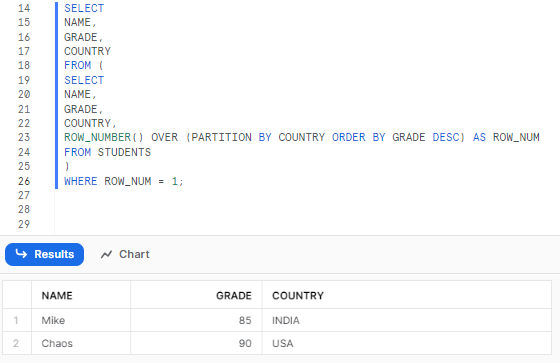
As you can see, the Snowflake QUALIFY version is much simpler in this case by avoiding the subquery syntax.
Example 2—Getting Percentage Threshold Using Snowflake QUALIFY
Snowflake QUALIFY also makes it easy to filter based on a percentage threshold calculated with window functions.
For example, we could get all students who scored in the top 50% for their country:
SELECT
NAME,
GRADE,
COUNTRY,
CUME_DIST() OVER (PARTITION BY COUNTRY ORDER BY GRADE) AS cumulative_distribution
FROM STUDENTS
QUALIFY cumulative_distribution <= 0.5;This returns students who are in the top 50% of grades in their country:
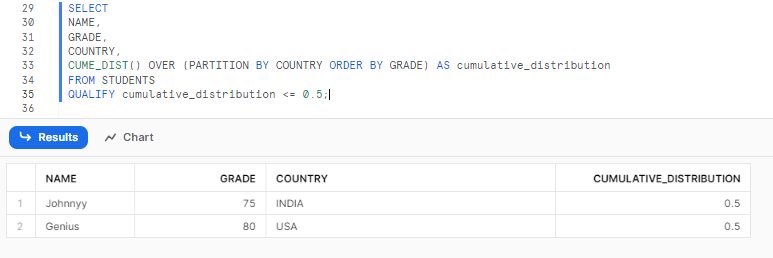
The CUME_DIST() window function calculates the cumulative distribution % for each student's grade within their country. Snowflake QUALIFY then filters this down based on that percentage.
Example 3—Filtering JOINs with Snowflake QUALIFY
Snowflake QUALIFY can also simplify queries that involve filtering joins.
Let's add a new COURSES table:
CREATE TABLE COURSES (
CODE VARCHAR,
NAME VARCHAR
);
INSERT INTO COURSES VALUES
('CS101', 'Computer Science'),
('MATH101', 'Math'),
('SCI101', 'Science');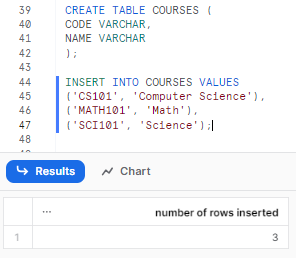
And a STUDENT_COURSES table to store course registrations:
CREATE TABLE STUDENT_COURSES (
STUDENT_ID NUMBER,
CODE VARCHAR
);
INSERT INTO STUDENT_COURSES VALUES
(1, 'CS101'),
(1, 'MATH101'),
(2, 'CS101'),
(3, 'SCI101');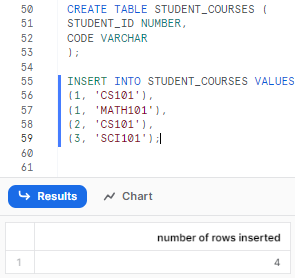
Now we can write a query to show only students along with their first registered course:
SELECT
s.name,
c.code,
c.name,
ROW_NUMBER() OVER (PARTITION BY s.student_id ORDER BY sc.code) AS course_number
FROM students s
JOIN student_courses sc ON s.student_id = sc.student_id
JOIN courses c ON c.code = sc.code
QUALIFY course_number = 1;This returns each student with only their first enrolled course:
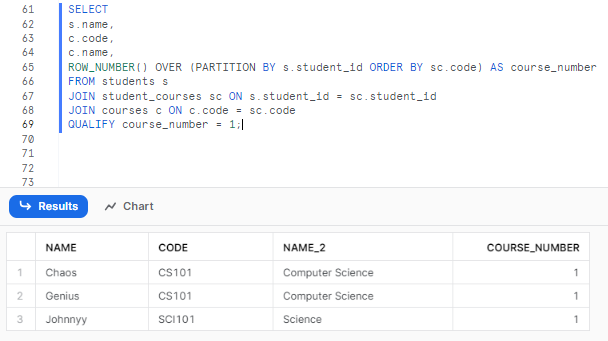
The JOIN finds all combinations of students and courses. But Snowflake QUALIFY filters this down to just the first row based on the ROW_NUMBER() window function.
Without Snowflake QUALIFY, we would need to perform the JOIN in an inner subquery, then filter the result in the outer query. Snowflake QUALIFY simplifies this pattern by handling the filtering in line.
As you can see from these examples, Snowflake QUALIFY clause provides a concise way to filter query results based on window calculations like ranking, distributions, and aggregates. Snowflake QUALIFY enhances readability by avoiding subqueries, especially for analytical queries that require top N, groupwise logic, percentiles—and similar processing. If you find yourself nesting queries just to filter on a window function, try using Snowflake QUALIFY to simplify things.
Snowflake QUALIFY vs Traditional Methods
Snowflake's QUALIFY clause provides a simpler and more readable way to filter results based on window calculations compared to subqueries or common table expressions (CTEs). In this post, we'll explore the specific benefits of QUALIFY over these traditional approaches.
Snowflake QUALIFY vs Subqueries
A common pattern in SQL is to compute window functions like rankings or aggregates in a subquery, then filter the results in the outer query. For example:
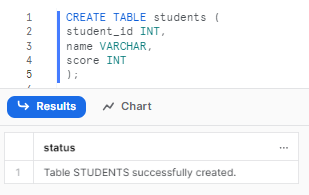
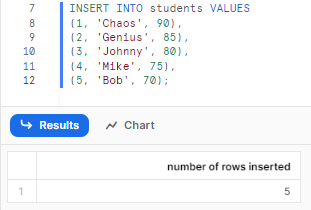
SELECT *
FROM (
SELECT *,
ROW_NUMBER() OVER (ORDER BY score DESC) AS rank
FROM students
)
WHERE rank <= 3;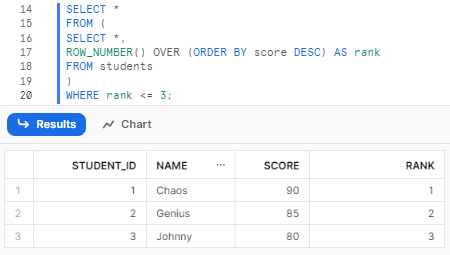
This query returns the top 3 students by score using a subquery to calculate and filter on the ranking.
With Snowflake QUALIFY, we can simplify this to:
SELECT *,
ROW_NUMBER() OVER (ORDER BY score DESC) AS rank
FROM students
QUALIFY rank <= 3;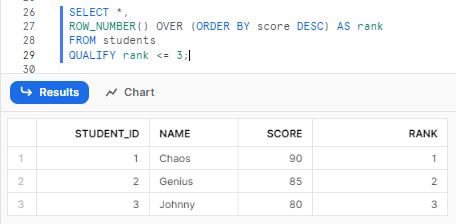
Snowflake QUALIFY lets us filter directly on the window function in the same query, avoiding the subquery nesting.
Some key advantages of Snowflake QUALIFY over subqueries:
- More readable and maintainable syntax by eliminating nesting
- Potentially faster performance by optimizing in a single query
- Simpler referencing of window functions compared to subquery aliasing
- Avoid duplication of window logic between inner and outer queries
In short, Snowflake QUALIFY streamlines analytical queries by handling the window calculation and filtering in one place.
Snowflake QUALIFY vs Snowflake CTEs
A common table expression (CTE) can also be used to pre-compute window functions before filtering in the main query. For example:
WITH rankings AS (
SELECT *,
ROW_NUMBER() OVER (ORDER BY score DESC) AS rank
FROM students
)
SELECT *
FROM rankings
WHERE rank <= 3;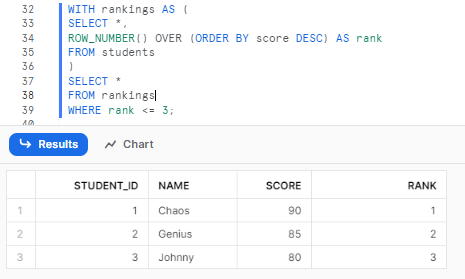
The CTE "rankings" handles the ranking calculation, then the main query filters on it.
With Snowflake QUALIFY, this becomes:
SELECT *,
ROW_NUMBER() OVER (ORDER BY score DESC) AS rank
FROM students
QUALIFY rank <= 3;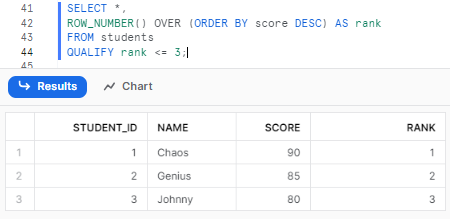
Again, Snowflake QUALIFY simplifies by avoiding the need to separate the window logic into a CTE.
Some advantages over CTEs:
- Don't need to split query logic across CTE and main query
- Avoid complex CTE chaining for multiple window calculations
- Query semantics are more clear in a single query block
- Potentially faster with optimization in one query
Difference between DISTINCT and Snowflake QUALIFY
| Snowflake DISTINCT | Snowflake QUALIFY |
| Eliminates duplicate rows from the result set of a query | Filters rows based on a conditional expression or window function |
| Removes rows where every column value is identical to another row | Enables filtering within groups or partitions of rows, rather than the entire set |
| Operates on the entire set of rows returned by the query before any projections or ordering | Can use flexible conditions involving columns, aggregates, ranking functions, etc |
| Standard SQL syntax supported by most database systems like Oracle, SQL Server, PostgreSQL, etc | Snowflake-specific syntax, not standard SQL. Useful for portability |
| Typically used for basic duplicate removal, such as getting unique values for a column across rows | Optimized for analytical queries that require conditional logic based on window calculations |
| The performance impact depends on the number of duplicates in the data. More duplicates means more work to remove them | The filter condition is evaluated after window functions and grouping. Optimized for analytics |
| Goes after SELECT and before FROM in the logical order of clauses | Goes after FROM, GROUP BY, HAVING in the logical order of clauses |
Difference between HAVING and Snowflake QUALIFY
| Snowflake HAVING | Snowflake QUALIFY |
| HAVING clause in Snowflake filters aggregate results after GROUP BY grouping | Snowflake QUALIFY clause filters rows based on a conditional expression or window function |
| HAVING conditions can reference aggregated columns produced by the GROUP BY | Snowflake QUALIFY enables filtering within groups or partitions of rows |
| Common uses are filtering groups based on sums, counts, averages or other aggregates | Can use flexible conditions involving columns, aggregates, rankings, and more |
| HAVING is similar to WHERE, but applies to grouped rows rather than individual rows | Snowflake QUALIFY is Snowflake-specific syntax, not standard ANSI SQL |
| HAVING is standard SQL syntax and supported by most database systems | Snowflake QUALIFY is optimized for analytical queries using window functions |
| HAVING only sees the aggregated data, not individual rows | Snowflake QUALIFY can reference both aggregated and individual row data |
| HAVING comes after GROUP BY in the logical order of clauses | Snowflake QUALIFY comes after window functions in the logical order of clauses |
Difference between WHERE and Snowflake QUALIFY
| Snowflake WHERE | Snowflake QUALIFY |
| WHERE clause filters rows based on conditions before aggregation | QUALIFY filters rows based on a conditional expression or window function |
| Evaluated early in query processing, right after the FROM table references | Evaluated after window calculations and aggregations |
| Operates on individual rows, not aggregated groups | Enables filtering within groups or partitions of rows |
| Supports standard conditional logic like =, !=, >, BETWEEN, etc | Supports flexible conditions using columns, aggregates, rankings, etc |
| Standard SQL supported by all databases. Critical for query fundamentals | Snowflake-specific syntax, not standard ANSI SQL |
| Conditions can reference individual columns only, not aggregates or windows | Optimized for analytical queries not possible in WHERE |
| Comes before GROUP BY in the logical order of clauses | Comes after window functions in the logical order of clauses |
What Should You Know About Snowflake QUALIFY's Impact on Query Performance?
Now, let's take a look at an in-depth explanation of what you need to know about the impact of Snowflake QUALIFY on query performance:
Performance implications of using QUALIFY
- Snowflake QUALIFY acts as a filter on row output after window function calculation. This filtering can optimize performance by reducing data volumes for subsequent query clauses like SELECT, ORDER BY, LIMIT, etc.
- Highly selective QUALIFY predicates that filter out many rows early in query execution can greatly improve performance. Non-selective predicates may have minimal impact.
- QUALIFY cannot optimize or skip window function execution itself since it comes after their calculation. But it can filter their results before slower operations like sorting, joining, aggregating, etc.
- Finding the right balance of filtering between WHERE and QUALIFY clauses is key for performance. Too much in WHERE may cause missing window calculations. Too little may allow unnecessary data into window functions.
- In most cases, QUALIFY will outperform subquery alternatives since it avoids the overhead of nested query layers.
Here are some facts and fiction about QUALIFY performance impact
Facts:
- Simple, fast Snowflake QUALIFY predicates are most performant. Subqueries and complex expressions in the predicate can add significant overhead.
- Snowflake QUALIFY's positioning in query execution makes it well-suited for optimization through row filtering.
- If no filtering is achieved by the predicate, Snowflake QUALIFY may have a negligible performance impact.
- Snowflake QUALIFY can optimize memory and disk I/O by reducing data volumes processed in later query clauses.
Fictions:
- Snowflake QUALIFY does not directly optimize window function execution since it comes after their calculation.
- Snowflake QUALIFY should not be assumed to always speed up queries. Its efficacy depends on the predicate, data distribution, query structure, etc.
- Snowflake QUALIFY does not change the complexity or computational cost of window functions themselves. It filters their results.
What Are the Benefits of Using Snowflake QUALIFY?
Snowflake QUALIFY clause offers several key benefits that enhance the efficiency and readability of SQL queries, particularly when working with window functions. The following is an in-depth look at these benefits:
1) Simplified Query Structure
Before QUALIFY, filtering the results of window functions required nested subqueries or Common Table Expressions (CTEs). This often led to more complex and lengthy SQL queries. QUALIFY streamlines this process, allowing for direct filtering in the same query where the window function is applied. This simplification makes the queries more straightforward and easier to understand.
2) Clearer, Cleaner Queries
It's all about making your SQL code easier to read and tweak. With the help of Snowflake QUALIFY, the intent of the query becomes clearer. It separates the logic of window function computation from the filtering criteria. This separation not only enhances readability but also makes maintaining and modifying the query more manageable.
3) Performance Optimization
By reducing the need for subqueries or CTEs, Snowflake QUALIFY can potentially improve query performance. It allows Snowflake to optimize the execution plan more effectively, as the filtering criteria are more directly connected to the window function computation.
4) Enhanced Analytical Capabilities
QUALIFY extends the analytical power of SQL in Snowflake. It makes it easier to perform sophisticated analyses, such as ranking, partitioning, and calculating running totals or averages, while simultaneously applying specific filters on the results of these operations.
5) Less Room for Error
When using subqueries or CTEs for filtering window function results, there's a higher risk of making errors, especially in complex queries with multiple levels of nesting. By making use of Snowflake QUALIFY, the query becomes more linear and less prone to errors, as it reduces the complexity involved in managing multiple nested scopes. Fewer complexities in your queries mean fewer chances to slip up. Without the jumble of nested queries, you’re less likely to trip over your own SQL steps..
7) Pinpoint Precision
Unlike the WHERE clause that filters rows before any computation, Snowflake QUALIFY focuses specifically on filtering the output of window functions. This targeted approach is more efficient for scenarios where the filtering criteria are dependent on the results of these functions.
Save up to 30% on your Snowflake spend in a few minutes!


Conclusion
Snowflake QUALIFY clause, a powerful yet underutilized feature in Snowflake's arsenal, revolutionizes the way we approach data filtering in SQL queries. It elegantly simplifies the process by reducing the reliance on CTEs and subqueries, making queries less cluttered and more efficient. Snowflake QUALIFY feature enhances overall query readability by bringing clarity and precision to complex data sets. It streamlines data analysis with its focused capability to filter results of window functions.
In this article, we covered:
- What Are Window Functions and Their Role in Snowflake?
- How Did Snowflake QUALIFY in Snowflake Evolve ?
- Syntax and Usage of Snowflake QUALIFY
- Practical Use Cases of Snowflake QUALIFY
- Snowflake QUALIFY vs Subqueries vs CTEs
- Difference between DISTINCT and Snowflake QUALIFY
- Difference between HAVING and Snowflake QUALIFY
- Difference between WHERE and Snowflake QUALIFY
- What Should You Know About Snowflake QUALIFY's Impact on Query Performance?
- What Are the Benefits of Using Snowflake QUALIFY?
…and so much more!
FAQs
What is Snowflake QUALIFY clause and its primary function?
Snowflake QUALIFY clause is used to filter the results of window functions in SQL queries, providing a more direct and efficient way to refine query results.
How does Snowflake QUALIFY differ from traditional SQL filtering methods?
Unlike traditional methods like subqueries or Common Table Expressions (CTEs), QUALIFY allows filtering directly on window function results within the same query level, improving readability and performance.
Can Snowflake QUALIFY be used with all types of window functions?
Yes, Snowflake QUALIFY can be used with various window functions, including aggregate, ranking, analytics, and offset functions—and more!
Can you use QUALIFY without window functions?
No, QUALIFY requires at least one window function in the query to filter on.
What are the key benefits of using Snowflake QUALIFY in Snowflake queries?
It simplifies queries, enhances readability, reduces the need for nested queries, and can improve performance by streamlining the query execution process.
How does Snowflake QUALIFY improve query performance compared to subqueries?
By filtering directly on window function results, Snowflake QUALIFY reduces the complexity and execution time of queries compared to nested subqueries.
What types of analytics can be enhanced using Snowflake QUALIFY clause?
QUALIFY enhances analytical tasks like data segmentation, trend analysis, ranking, and complex aggregations.
How does Snowflake QUALIFY impact the readability and maintainability of SQL queries?
It improves readability and maintainability by reducing the complexity of queries and making them more straightforward and concise.
Can Snowflake QUALIFY clause be combined with GROUP BY and HAVING clauses?
Yes, QUALIFY can be used alongside GROUP BY and HAVING clauses for more complex data aggregations and filtering.
What are some common use cases for implementing Snowflake QUALIFY in data analysis?
Use cases include time-series data analysis, customer segmentation, sales ranking, and calculating running totals or averages.
How does Snowflake QUALIFY clause streamline complex SQL queries?
It streamlines queries by allowing direct filtering on window functions, eliminating the need for multiple subqueries or temporary tables.
Does Snowflake QUALIFY support the use of aggregate functions?
Yes, Snowflake QUALIFY can be used with aggregate functions within window functions.
What are the syntax rules for using Snowflake QUALIFY clause in a SQL query?
QUALIFY is placed after the window functions in a SELECT statement and uses conditions that usually involve the window function's result.
How does Snowflake QUALIFY handle partitioning and ranking in SQL queries?
It efficiently filters results after partitioning and ranking are applied, allowing for precise data extraction based on ranked or partitioned data.
Can Snowflake QUALIFY clause optimize window function execution?
Yes, by reducing the number of rows processed and eliminating additional layers of subqueries, QUALIFY can optimize window function execution.
Does QUALIFY filter groups or rows?
QUALIFY filters individual rows, unlike HAVING which filters groups.
What types of predicates can you use in Snowflake QUALIFY?
Standard comparison operators, boolean logic like AND/OR, BETWEEN, IN, etc.
Can QUALIFY use subqueries or CTEs?
Yes, subqueries and CTEs are valid inside a QUALIFY predicate.
Can QUALIFY refer to columns from multiple tables?
Yes, as long as the tables are properly joined, Snowflake QUALIFY can reference columns from multiple underlying tables.
How does Snowflake QUALIFY clause compare to DISTINCT in SQL querying?
Snowflake QUALIFY is used for filtering window function results, while DISTINCT is for removing duplicate rows. They serve different purposes in SQL querying.






































